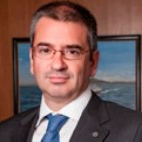2025 POST SHOW REPORT
COLLABORATING TO DRIVE THE GLOBAL DECARBONISATION OF THE MARITIME INDUSTRY
For many, this postponement is a setback. It slows the momentum for low-carbon fuels, delays key funding and policy mechanisms, and creates an uneven playing field between regions such as the EU, where regulation continues to move ahead, and global operators who depend on a unified approach.
But while global regulation has paused, the market cannot. Vessels are still being ordered, compliance costs are already active under the EU ETS and FuelEU Maritime, and investment decisions are being made today that will define the next two decades of shipping. The absence of regulatory certainty does not stop the transition; it only increases the risk of getting it wrong.
This is where the Global Maritime Decarbonisation Summit becomes even more critical. Without global alignment, industry collaboration becomes the only reliable mechanism to move forward. The coming year must be used to strengthen fuel pathways, prepare for any regulatory outcome in October 2026, and ensure that investments being made today will not become stranded tomorrow.
This year’s discussion goes far beyond comparing fuels. The focus is now on understanding which fuel strategies will yield the lowest commercial risk under uncertain policy conditions, and how shipowners, fuel suppliers, ports, and investors can collectively shape a more stable market.
Along with the regulatory urgency, we are also in the height of increasing demand for LNG-fuelled ships, and in turn LNG infrastructure. [Of the 151 alternative-fuelled vessels ordered in H1 2025, LNG accounted for 87. In the first half of 2025, 13 LNG bunkering vessels were ordered]. Alternatives continue to grow infrastructure, but the biggest challenge currently here, is the long offtake agreements needed to provide the fuel and build the plant – a long-term investment is a big risk among uncertainty – so how will these fuels compete?
THE 2026 COUNTDOWN HAS BEGUN!
BENEFITS OF ATTENDING

Advance your decarbonisation strategy by engaging directly with stakeholders including fuel suppliers and industry leaders and understanding the market projected availability

Gather in one central forum to discuss not only current operational challenges within well-established LNG pathways, but also what viability in the multi-fuel approach there is for your fleet

Prepare your organisation for FuelEU Maritime and EU ETS compliance by learning from experts, and gain a competitive edge through new technology and infrastructure in emerging fuel sectors.
INFOGRAPHIC
From Waiting to Action: How the IMO’s Net Zero Review Will Redefine Maritime Progress
The IMO Marine Environment Protection Committee (MEPC) has now met, and the industry is waiting to hear what its October 2025 decision means for shipping’s path to Net Zero. As the Committee reviews the Net-Zero framework and the implementation of new carbon intensity measures, one thing is clear: the pace of maritime decarbonisation is about to accelerate.
To stay compliant and competitive, you need to know exactly what’s changing, when, and how it impacts your operations. This Decarbonisation Key Dates Timeline infographic lays it all out clearly, helping you prioritise near-term actions while preparing for the next wave of IMO-driven regulation.
RELIVE THE STANDOUT MOMENTS FROM 2025
IN OUR OFFICIAL SHOWREEL!
KEEP UP TO DATE: Follow us on LinkedIn
Catch up on the latest industry news in our newsletter, event updates announcing new speakers and industry content with insights that cannot be missed.
WHO WILL YOU MEET?

Operators/Builders/
Designers

& Terminals

Utilities

Companies

Societies


Suppliers



Presidents, MD’s


Development

Specialist

Managers

Specialists

Managers

Advisory


Managers
JOIN US!
Whether you’ve been a part of the LNG discussions, or you are focused on exploring alternative fuels and technologies, this summit is designed for you.
We invite the entire maritime supply chain—shipowners, operators, fuel suppliers, technology providers, regulators, etc —to join us in understanding the impact of new regulations, assessing the progress of alternative fuels, and shaping the strategies that will define the future of maritime decarbonisation.






















































